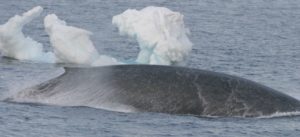
Flinders University scientists have uncovered crucial DNA evidence about the number and distribution of populations of the world’s largest animal, the critically endangered Antarctic blue whale.
Antarctic blue whales were killed in the hundreds of thousands during 20th century whaling, dropping from 239,000 to just 360 individuals.
“Before we can even contemplate how to best protect Antarctic blue whales, we need to know the number of their populations and their locations,” said Flinders University School of Biological Sciences researcher Dr Catherine Attard. “This is a formidable task.”
Even though these whales reach over 160 tonnes – the maximum weight ever known for any animal – and 30 metres long, finding a rare and highly mobile species in a vast and remote ocean is akin to finding a needle in a haystack.
International, collaborative vessel surveys for non-lethal research of whales have been conducted in the Antarctic under the International Whaling Commission (IWC) since 1978. It’s been slow-going, but fruitful.
Biopsy samples have been collected during these surveys from live blue whales. A biopsy sample is a small piece of skin and blubber, and the source of precious DNA.
“By comparing similarities and differences in the DNA of blue whales, we can tell which individuals are part of the same population and estimate the number of populations,” said Flinders Professor Luciano Beheregaray.
“Our study was based on the largest genetic dataset to date for this species and included samples from 142 Antarctic blue whales. We found three groups of genetically similar individuals that represent separate populations”, said fellow Flinders researcher Associate Professor Luciana Möller.
Three populations makes sense given what is known of the behaviour and biology of this species.
Antarctic blue whales feed in the Antarctic during the summer and migrate towards the equator to breed in the winter. This means when Antarctic blue whales breed, they may split into three different oceans that equate to the three populations.
“What really surprised us was that these populations co-occupy areas throughout the Antarctic, rather than occupying discrete areas like their humpback whale cousins,” Ms Attard said.
The blue whale populations likely move around the Antarctic to locate their sole food source, krill. Blue whales require high densities of krill to support their massive energy requirements.
“We have provided a piece of the population puzzle, but still have far to go before we can properly monitor and conserve these populations. We need to determine their breeding ground locations and then confirm their population structure,” said Associate Professor Möller.
The researchers say this would ideally be performed by continuing the international vessel surveys in the Antarctic and conducting associated satellite tagging of Antarctic blue whales to find out their migratory destinations. The whales themselves can thereby show the way to their breeding grounds.
“Understanding the number and distribution of the populations is imperative for appropriate conservation because the populations may differ in abundance trends and current anthropogenic impacts at their breeding grounds,” said Ms Attard.
The findings have been published by the Nature Publishing Group’s Scientific Reports.
The study was possible through funds for genetic analyses provided by the Australian Marine Mammal Centre within the Australian Antarctic Division, and samples collected through the International Decade of Cetacean Research and Southern Ocean Whale and Ecosystem Research programs of the International Whaling Commission.

